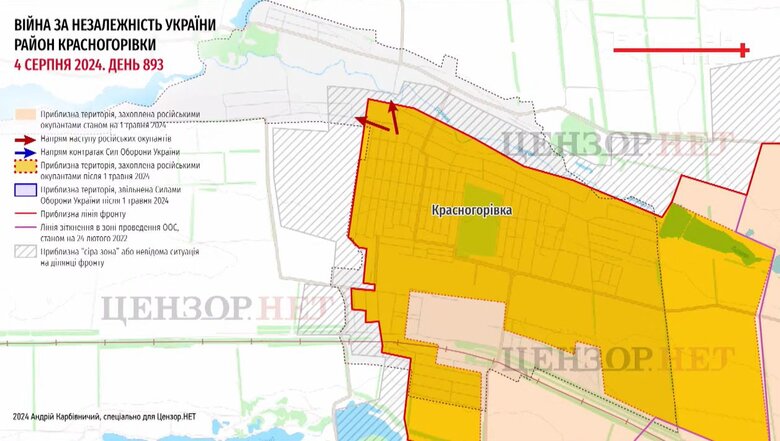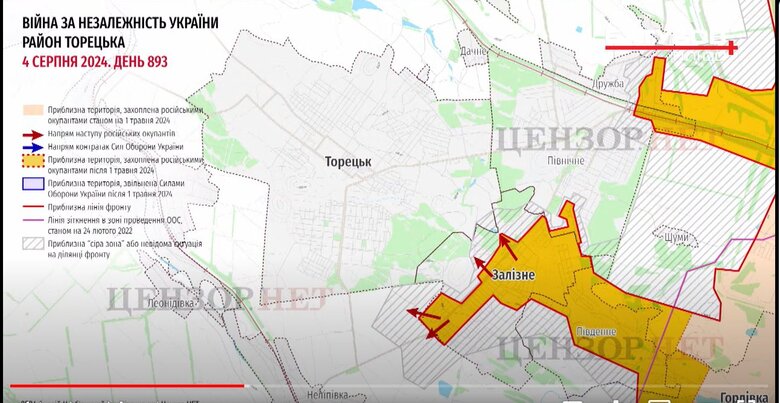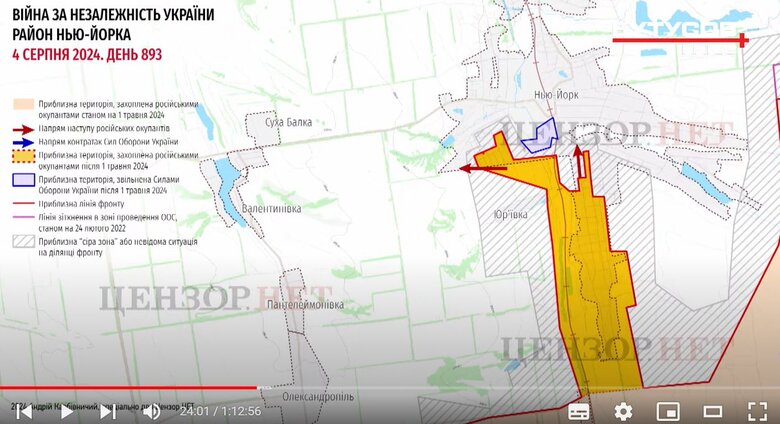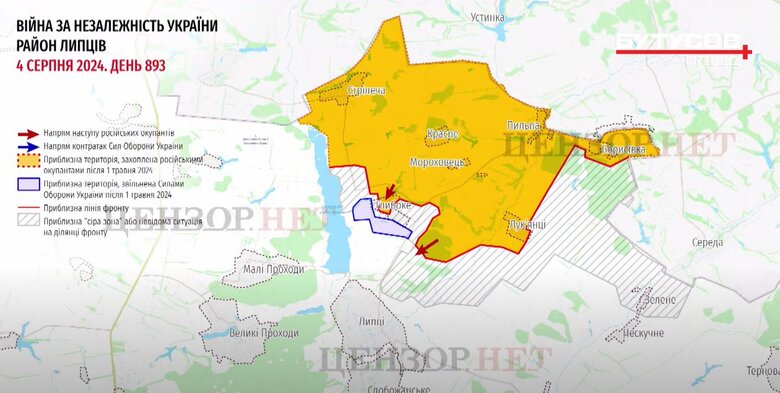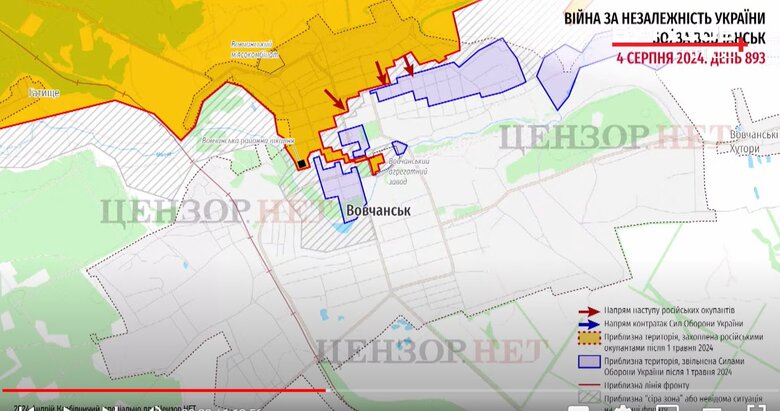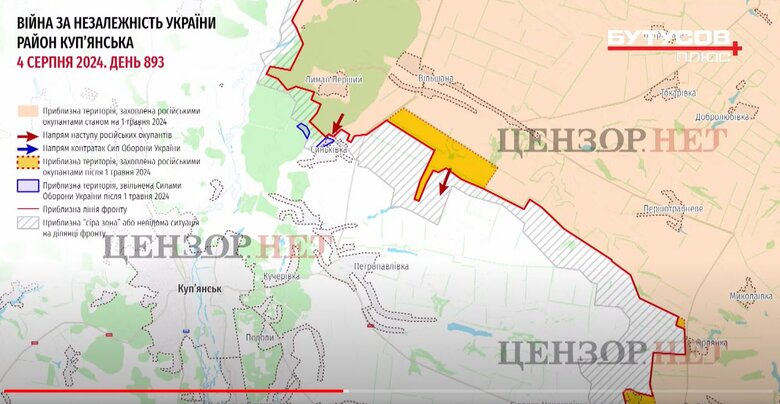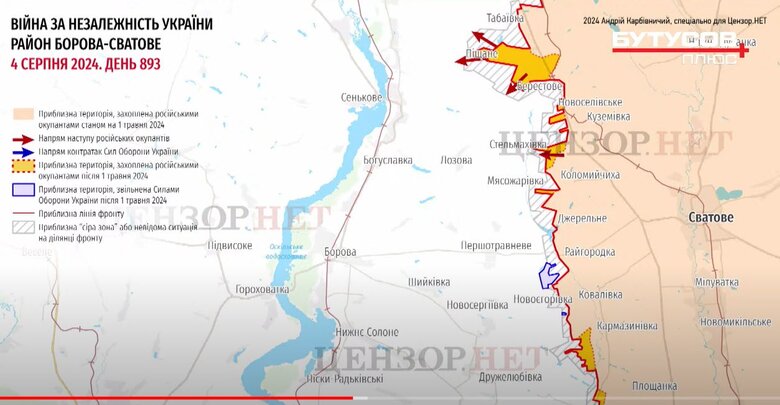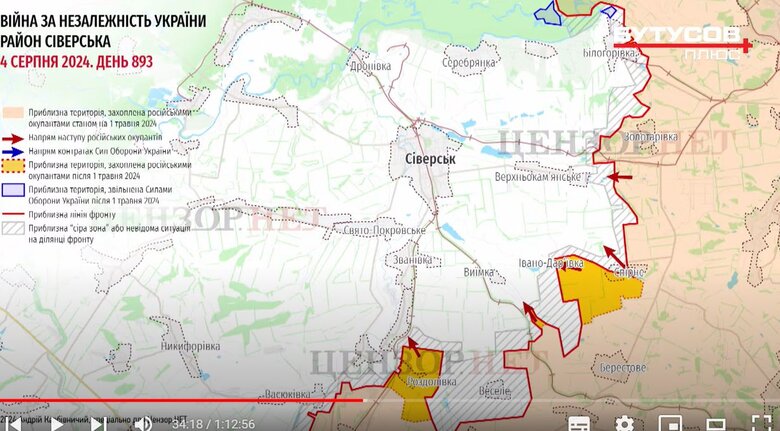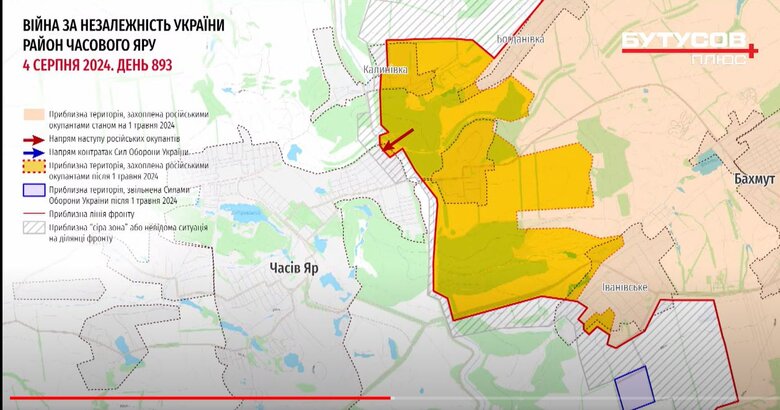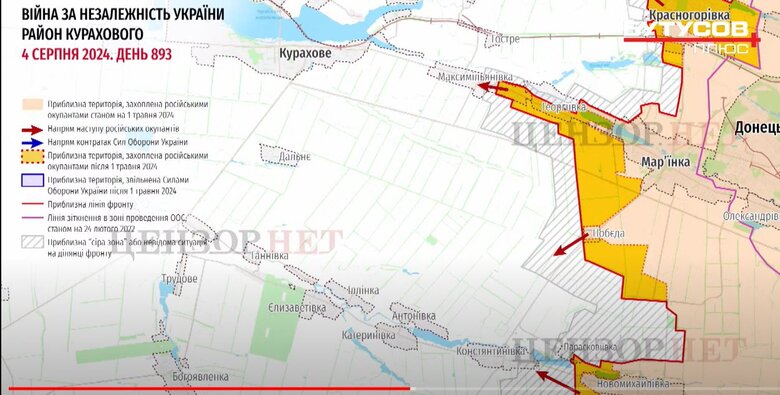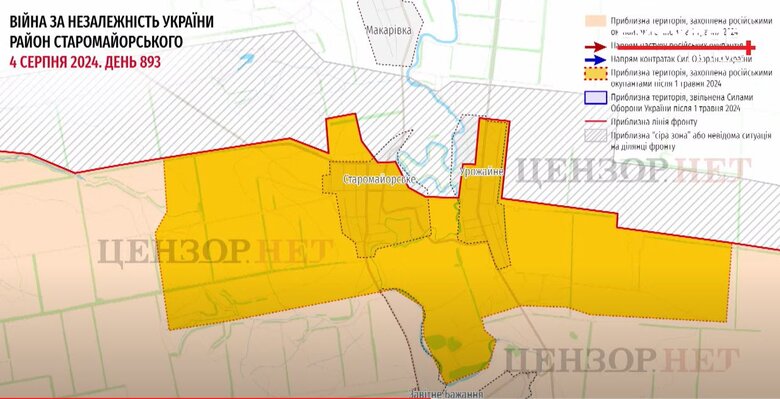How to defeat Russian offensive?
The stream is devoted to an overview of the situation at the front and what distance Russian troops have managed to advance along the entire front in recent months, starting from May 1.
The Russian offensive has been going on for many months now, and they have been conducting active hostilities for almost the entire year. And on the frontline, many people, many of our military, commanders primarily, soldiers, everyone who performs combat missions, have big questions about when such organizational management measures will be taken by us to stabilize the defense. Unfortunately, stabilization of the defense is a purely political phrase. We remember that after Valerii Zaluzhnyi was dismissed from the post of the Chief of the Armed Forces and Oleksandr Syrskyi was appointed, there were a lot of narratives in the state media. The leadership of the state, President Volodymyr Zelenskyy, claimed that stabilization had begun at the front. Unfortunately, all the words about stabilization remained just words. There is no stabilization, and when Zaluzhnyi was being dismissed, I wrote and spoke here on the air that the problem is not in the surname, not even in the fact that there is a person with some different visions. The war is very complicated now. The problem is that the war has to be administered effectively, resources have to be managed. The war is large, large-scale. It is going on in the technological dimension, in the administrative dimension and in the dimension of human resources. And all of this must be efficiently administered and applied. This is not a matter of some kind of search, some single move, some panacea, what to do. We need to understand what the order of change should be. Unfortunately, this has not been done, and we see the consequences of this.
As far as that staff are driven out, volunteer cadre personnel of the Armed Forces, the Defense Forces of the National Guard, who came to the war in 2022 and repeatedly defeated Russian troops, as far as we suffer losses, there is no adequate replacement at the front and, unfortunately, neither replenishment nor reserves are being prepared. And a big question arises about the quality of management. There are serious problems with this, and management is the main problem why the enemy manages to advance. And the offensive is going on, in principle, on most of the front, and it does not stop.
The situation is very threatening and requires serious, strategic decisions. In the Pokrovsk direction. This is the main area where the enemy has managed to advance. This is the most intense area of the frontline. 893rd day of the full-scale Russian invasion, August 4, 2024. At the moment, we can see that the enemy has managed to advance very significantly from the Avdiivka area over the past two months. And now Russian troops are advancing on Myrnohrad.
This yellow area is the territory that Russian troops have captured since May 1. This means that in two months, Russian troops managed to capture a significant amount of territory. There is also a shaded area here. This is the territory that is being fought over. Unfortunately, a significant part of this shaded area is also currently occupied by the enemy. That is, the Russian advance, unfortunately, does not stop. Yes, they are advancing 100-200 meters a day. But the problem is that they do it almost every day. Yes, we have a lot of videos, and in the next broadcast, we will show the best strikes of our soldiers against the Russian occupiers. All this is very difficult for the Russian infantry. The Russians are essentially conducting frontal attacks with small infantry groups. They suffer heavy losses, but they cannot stop them, these infantry attacks. And the enemy continues to advance. Unfortunately, there is a very convenient military line in the area of Zhelanne and Ivanivka. Unfortunately, we cannot hold these water lines. Why not? Because there is no organized defense line there. There are no troops deployed on this line. And along the railway line, we see the brown icon of the railway line that goes from Avdiivka to Pokrovsk, the enemy continues to advance. All this time their direction of advance is the railroad track. And they crawl, crawl, crawl along it. And then they expand the breakthrough in different directions. Unfortunately, the enemy has the tactical initiative in this entire area. And the enemy's offensive continues.
Yesterday there was a very resonant event. This is the main problem now, friends. They are advancing, in fact, they have already crawled to Hrodivka and Novohrodivka. Unfortunately, this is already the frontline zone. And the enemy is 13-12.5 kilometers away from the city of Myrnohrad, if you go in a straight line. It's about 12 kilometers, a little more, to the city of Myrnohrad. And the city of Myrnohrad is one agglomeration together with the city of Pokrovsk. The enemy's approach to Myrnohrad, the loss of Myrnohrad-Pokrovsk, means the loss of the largest agglomeration in the area, the largest communication hub in this part of Donbas, the most convenient position of the defense line. And this is a really critical situation for all of us, for Ukraine, for the fate of the Ukrainian Donbas. It is a critical situation. Unfortunately, the situation is of great concern.
We have seen a video message from the soldiers of the 31st Mechanised Brigade, who asked not to dismiss their brigade commander. I understand our soldiers, this is not the first appeal in recent days. The 31st Mechanised Brigade is in this area, in the direction of Myrnohrad. The brigade is newly formed, it completed its formation in the year 2023 and immediately went into battle. There were immediately big problems with combat capability, and they manifested themselves. This year, the brigade commander was replaced to strengthen combat capability, and he hadn't even been in office for six months when he was also dismissed. He was appointed by Oleksandr Syrskyi and is being removed by Oleksandr Syrskyi. Why is this happening? Well, I want to tell you that I communicate with almost all formations in this area, with the command of these formations at different levels, with the commanders of our units, subunits. No one is saying that the main problem here is that there is a single brigade commander who is not doing something. The main problem is that the enemy has an advantage in numbers, an advantage in means of destruction, and the only way to counter the enemy is to take better-organized actions, and these actions are not taking place.
Until now, when we actually see this line, perhaps someone thinks that it is some kind of fortification line. Do you remember how long our leadership, the authorities, told us that the troops were withdrawn to pre-prepared positions? Unfortunately, friends, this is a lie. No pre-equipped positions that would be reliable have been prepared in this area. Yes, in the area of Ocheretyne, in several other areas, in the rear, several positions were dug, I saw them along this line, but the troops are not taking up these positions. Why? Because it's all just a show, it's not tied to the terrain at all. The positions are being dug where it is convenient for excavators and civilians who are hired, i.e. in an open field. Sometimes concrete buildings-dugouts are built, but they are not dug into the ground, but built like these old-world pillboxes, perhaps, before the First World War or before the First World War, which are very clearly visible, they are built again in the open terrain, not in plantings, not camouflaged, they are very clearly visible. These positions are not covered by drones from above, so they are clearly visible, they are not covered.
I want to tell you, friends, that all these defensive positions that are being identified and reported there are a complete show, an imitation, unfortunately. The troops do not take up these positions. Who takes them up? Well, only sometimes enemy assault groups, when they need to escape from our fire during the next bounding when they go on the attack. Unfortunately, this is a sad reality. That is why, dear friends, this situation in Myrnohrad-Pokrovsk is of the greatest concern, and I am most shocked that the authorities and the telethon do not notice it at all. Why isn't Volodymyr Zelenskyy at this key point? Why isn't he even looking at what's going on there? Well, it's his responsibility. His subordinates are digging these positions directly. That is the responsibility of the civil-military administration, it is its responsibility to dig, it is a direct presidential vertical. The Supreme Commander-in-Chief himself has repeatedly given instructions, even issued a decree on the construction of defense lines. Why doesn't he check how they are being built? Are the troops taking them up? Why are these defenses not being taken up by troops at all? Why does the enemy continue to push through all these defenses without any problems? There is no control of responsibility. And now, because of this irresponsibility, the Myrnohrad-Pokrovsk junction is in great danger. This is a big threat to the entire Ukrainian Donbas. The consequences will be very severe.
Pokrovsk district on the border with the Dnipropetrovsk region. And all this should provoke a maximum reaction from the country's leadership. And what do we see? The enemy has approached 12 kilometres, and the commander of the 31st Brigade is being dismissed from his post. In other words, the military command has abdicated its responsibility. Oleksandr Syrskyi also says that all our problems are in the brigade commanders. Let's change the brigade commander again. Another charade? This one has been here for half a year, let's appoint a new one. During the enemy's offensive. Is this an adequate solution? Unfortunately, I have to say that this decision to dismiss the 31st Brigade's brigade commander is again a complete desire to absolve themselves of responsibility and replace the essence of the problem simply by temporarily finding a scapegoat. And who else will be dismissed during this time, while the enemy continues to move towards Myrnohrad? All other brigade commanders as well. Can someone higher up be dismissed too? Not only brigade commanders. Unfortunately, we have a system of lies in the top leadership, especially at the level of the Headquarters of the Supreme Commander-in-Chief, which simply makes it impossible to analyse military events adequately. It simply makes it impossible. Nothing can be done.
We understand what is happening. The enemy is advancing, and no normal defence line is being set up in the rear on the second line. Why? Because to equip an adequate defence line, you need to send troops there. And we don't have a second line. The troops are deployed to the second line, and immediately the brigades that are set in there, for example, the newly formed 142nd Brigade was set in. And they immediately spread it out. Back and forth, back and forth, the reserves were spread out, the units were spread out. How can you fight like that? It's absurd. You can't fight like that. Instead of building a reliable defence on the second line of defence, setting up troops there, allowing the troops to prepare the area, we will have encounter battles again. Somewhere there is a breakthrough, and then whoever is there is thrown into this breakthrough. In fact, we are trying to stop the Russian offensive from Avdiivka in an encounter battle mode. We have no defences anywhere. But it doesn't work, the enemy has more reserves, and the war is an exchange. Even one to two is a normal exchange for them. To stop them, we need to kill them in a different proportion. To do this, it is necessary to organise command, intelligence, and interaction between troops. Who is responsible for this? Operational and tactical command, operational and strategic command. And in our country, these bodies have long ago turned into bureaucratic structures that are constantly either providing official explanations for some tens of thousands of investigations. Or they write OIs, operational instructions. To restore the situation, to do this, to do that, to reach a point that is completely detached from the tactical capabilities, combat capability of the troops. This is the reality. And this can be said if, for example, Volodymyr Zelenskyy suddenly becomes interested in what is happening at the front, why we cannot stop the offensive on Myrnohrad. Maybe he will show some interest, interest at the Headquarters. All these are just words there. We need to do something about it. And if the country's leadership were interested, they would find out that no defence line has been prepared, no defence line has been taken up by troops in advance, there is no interaction, no centralised use of drones and electronic warfare.
What is there? A lot of reports, papers, thousands of orders that cover each official. And that's it. And the enemy continues to crawl 100-200 metres a day, and they continue to crawl. They are being killed with heavy losses, there is video, our soldiers are doing their best. But there will be no miracle. Where management needs to be organized, miracles will not happen. You need responsible management decisions. There are none in this area of Pokrovsk and Myrnohrad. And I can say that, unfortunately, Oleksandr Syrskyi is deeply mistaken in his assessment and the situation. His manual control is ineffective in this area. Absolutely. His dismissal of the 31st Brigade commander does not correspond to the situation. And not only the personnel do not understand this, the commanders of other units in the area also do not support it and do not consider it an objective decision. So, to be honest, if the enemy comes even closer, and this game continues, what should we do? Then we have to show even more responsible persons. The OTG commanders who provide false information, recently OTG commanders have been replaced. And another one has been appointed. So what will be the response of the country's leadership? Replacing some officials or solving the problem. This is the main thing. Therefore, dear friends, this Pokrovsk-Myrnohrad situation is a failure, and it is a failure not at the level of the brigade commanders, but at a higher level, at the level of the organization of combat operations. This is a failure of the Headquarters of the Supreme Commander-in-Chief. This is a failure of the leadership of the Armed Forces in this case. And if this failure is not corrected, the enemy will capture more Ukrainian cities. Just like they captured Krasnohorivka in July. The town of Krasnohorivka. For some reason, no one reports its loss. Apparently, this is not really interesting in a telethon anymore. We need victories instead of solving the current problems of the war.
Yes, the direction of Krasnohorivka. The situation in Krasnohorivka. In fact, the town is lost. Formally, there are our units on one of the streets that is part of the town, near the cemetery. But in fact, friends, unfortunately, the enemy has captured the entire construction area, all the houses, factories, everything, including the railway station. And he continues to advance in this direction. This is, of course, a very serious problem. I also talked about it, I said that there are inadequate actions of the commander of the 59th Brigade, just a young man who was entrusted with a large number of troops. He could not cope with the task. Again, this is what his subordinates say. Unfortunately, there were no personnel decisions. Oleksandr Syrskyi dismisses brigade commanders who are supported by the personnel, who are leaders in the team, while some brigade commanders who are not supported, who are criticized by the personnel, who are not able to fulfill the task, are kept in their positions despite everything. Where is the logic?
The brigadier of the 31st Brigade, who was dismissed by Syrskyi, lost several positions, they forced back several kilometers. This is true. Given that the brigade is newly formed, it is weak. In contrast, the 59th Brigade is a combat-ready brigade that was handed over to the current brigade commander Shevchuk in an absolutely combat-ready state. And he lost the town of Krasnohorivka in a few months. And he remains in office. Because the command likes him. It doesn't matter what was lost, how many kilometers, what positions. What matters is whether they like him or not. There are no objective criteria. No one takes into account the condition of your troops, the condition of the defense lines, the amount of ammunition, the combat capability, the strength of the enemy. None of this is taken into account. There is no system. That is why I have said many times on the air that our troops do not use the after-action review procedure. And because of this, we can make an objective assessment of the competence and adequacy of our commander. But it's impossible to make them simply. These are all subjective assessments that must be based on the real situation, must be based on assessments in the combat team, on assessments of enemy losses. We see that it is possible to lose a few kilometers and lose a post in a weak brigade. Or you can lose a city and a very large number of positions and remain in office. Just because people like you. Well, this is a sad reality.
The situation in New York-Toretsk.
The enemy is advancing into Toretsk. The advance, I cannot say that it is deep, but it is being held at bay, although it is being held at bay a at a very heavy price. The enemy continues its offensive. Our soldiers are just holding on with all their might, doing their best. Of course, we can still fight for the city. We can fight for a long time. It is, of course, very difficult to do this in all conditions. The 32nd Brigade, which entered the area, the soldiers of the 95th Brigade who are there are fighting, some other units in the area, they are now being sent to reinforce them, they are doing their best, of course. But since the defense line there was not prepared, the 2nd line, the 3rd line, of course, this encounter battle is causing heavy losses not only to the enemy but also to our troops. This is a big problem. And, unfortunately, we have seen quite a significant advance since the beginning of May. This is the yellow advance since the beginning of May, see? The enemy is advancing further. The areas that are shaded, they are very quickly passing gradually, week by week, under the control of the Russian occupiers.
New York, what's the situation?
We see the same yellow advancement over the last 2 months. And I want to tell you that the advancement, well, it's literally the last months, this yellow advancement that the enemy is making, they have actually captured half the city, actually half the city is under the control of the enemy. And the battles are going on in New York itself, heavy battles are going on. The enemy is being hit by our units here. Our 53rd Brigade is also trying to stop the enemy here, as well as the fighters of the 100th Brigade. Our significant forces are also rushing here. And given the fact that there is no defense line in the city itself, the city is not prepared for combat operations, of course, all this is very difficult. The counterattack continues. Nevertheless, the enemy's advance has stopped, and it is very, very difficult for them to pass. The losses are heavy. Yesterday (August 3 - ed.), for example, I saw how in one of the battles the soldiers of the 425th assault battalion "Skala"("Rock") took 15 Russian prisoners. In one of the battles, 15 Russians from the 9th Motorized Rifle Brigade of the Russian Armed Forces, the "Assault Detachment," surrendered as a result of a well-organized counterattack by our troops. And this shows, in fact, that I talked to the prisoners and, I want to say, it is not my impression that this enemy has any special new tactics. It's just ordinary infantry, there are people of different levels who are being forced there from all over the Russian Federation, from the occupied territories. This is an enemy that can be defeated if you have such an effective proper organization of combat, proper organization of management, proper use of people so that people do not get overworked, are fresh, and are combat-ready. And if you organize defense properly, you can hit the enemy.
The "Assault Detachment" of the 9th Brigade, they are constantly replaced one by one, but in this case, they were defeated in the area of the grain elevator. And this defeat happened because the enemy was stopped, not allowed to advance, suffered losses on the way, the assault detachment was stopped, the defense was properly organized by our fighters in this area, the enemy was not allowed to move further forward, to advance into the city, was hit by fire, the rest of the assault company was dispersed in several buildings. And then our soldiers, an assault group of eight soldiers, fighters, just conducted such a short attack and killed a large number of Russian troops, Russian soldiers. And in two days they took 15 prisoners from the assault group. This is quite an illustrative story, and the same thing is happening on the entire frontline. In other words, where the enemy can be stopped, there are organized actions, counterattacks can be carried out, impressions can be made, and the enemy is stopped and destroyed. Unfortunately, this requires a very high-quality management of the organization of troops.
Thus, in the Lyptsi area, there was a Russian offensive in two months. This advance, this is all yellow in the Lyptsi area near Kharkiv. The enemy managed to achieve all of this yellow advancement in just two days. In other words, the Russian offensive began on May 10, and it lasted for three days. On May 10, 11, 12, the enemy managed to capture this territory. They approached, and there are no marks of counterattacks by our troops on the map, but in fact the enemy reached the border, the village of Lyptsi, which is very important. In this area, which is of great operational importance, it is a key junction on the approaches to Kharkiv, the enemy managed to get to Lyptsi, and this entire shaded area is the actual area from which they were driven out. And the soldiers of the 92nd Brigade and the 13th Brigade of the National Guard of the Charter, which is directly fighting for Lyptsy, drove them out. The enemy was repelled, but they still have this area. This yellow one is from three days ago. Since May 12, there has been no advance of Russian troops in this area. On the contrary, the Russians were driven back from Lyptsi. The situation also seems simple and stabilized at first glance. In fact, all this stabilization is also the result of good management, organization of the battle and the fact that intense fighting has been going on there all this time. There are encounter battles in the forests. There is no defense line around Lyptsi, and the positions have not been equipped for two years. But our soldiers, thanks to the right managerial and organizational decisions, have stabilized the defense lines, built them and are now digging in with shovels and advancing a little bit.
Vovchansk. This is also what we saw. The enemy made the main advance on the outskirts of Vovchansk on May 12. Our troops also entered the city on May 12. And since then there have been fierce battles. There is a small yellow fragment here. The enemy has penetrated, made its way into the city center. So our positions in the center of Vovchansk were captured by our troops on the night of May 13. All this time, very fierce, heavy fighting has been going on for this small piece of Ukrainian land. The enemy manages to get through the one-story buildings there, but there are multi-storey buildings where the fighting is going on. Now, after the Russian fire, these are the remains, the ruins of the city. The fighting is still going on. The enemy is not able to gain a foothold. Our soldiers, the 57th Brigade, the 36th Brigade, and other units are fighting very well against the Russians. And the enemy is not able to drive our troops out of the city, to drive them across the river. The fighting is ongoing, very heavy. It may also happen that the enemy's advance since May 13 is insignificant, but in fact it is a minor advance, because very heavy assaults are constantly repelled every day, attacks are repelled, and the enemy is being ground down on the approaches. Therefore, there are also very fierce engagements here.
Kupiansk area. We have seen the advance of Russian troops since May 1, it is also there, it seems insignificant, but the enemy is also advancing, the offensive on Petropavlivka and Kupiansk continues, the Russians are advancing and the fighting is very difficult. Here, too, the advance is insignificant, but the enemy manages to drive us out of very important borders and approach the heights that control the city of Kupiansk itself. And this is the biggest threat. Here, the advance is small, but the enemy also manages to keep the tactical initiative in this area.
Borova-Svatove area. We see such one yellow salient, the enemy is advancing. Unfortunately, in the Borova area, the enemy attacked the 3rd Assault Brigade for a month and a half, all attacks were repelled, but after that the Russian command struck in the Tabaivka area, in the Berestove area, in other areas, and they managed to advance. This is a very dangerous, threatening advance. The enemy is rushing towards the Oskil River, and the fact that they have managed to break through the defences and advance is, of course, a very big challenge for us. The Russians are trying to use their superiority in this area to reach Oskil in at least one section. The situation is very difficult and very complicated in this area. There are also constant battles and attacks.
Siversk area. The situation here is very serious and difficult. The enemy continues to advance here. Soldiers of the 54th Mechanised Brigade are repelling Russian attacks in the area. They have also been reinforced by a subdivision, a battalion, the third battalion of the 4th National Guard Brigade, the Svoboda (Freedom) battalion. The cadre is made up of volunteer fighters. There are heavy battles for Spirne, the village of Spirne, and around it. Attacks are going on all along this area. The enemy manages to advance, to actually overwing. The situation in the area of Spirne is particularly dangerous, friends, very difficult. The enemy also has a tactical initiative here and a significant advantage in ammunition. There are also very heavy battles going on.
Chasiv Yar area. The enemy managed to advance, actually capture the part of the city that was behind the canal, and significantly improve their tactical position. Now they have created all the conditions to make a forced crossing of the canal, cross it, amass and storm, and enter the main part of the city. The enemy is in control on the other side of the river, they have captured a microdistrict with high-rise buildings. This allows the enemy to deploy antennas and surveillance equipment, drone antennas there. And to get basements for the accumulation of infantry. That is why the Russians have suffered heavy losses in the Chasiv Yar area. Now they are amassing and regrouping to enter the city itself. There are also very heavy battles here. This offensive, this seizure of this territory came at a very heavy price for the Russian troops. Unfortunately, we also suffered significant losses. The situation here is very difficult. But now our soldiers have stabilized the situation. The 5th Assault Brigade, the 24th Mechanized Brigade, and the 23rd Mechanized Brigade are there. And the soldiers are doing their best to save the town of Chasiv Yar. Again, the enemy has the tactical initiative here as well.
Kurakhove area. We see that the enemy has indeed made significant progress in this area since May 1. The enemy is rushing to Kurakhove itself, the town is already quite close. The Russians are also trying to deploy from the area of Peremoha and Novomykhailivka. They are trying to drive in a salient and launch their offensive both on Kurakhove and to the north, in the area of Vuhledar. In order to collapse our entire front in the southern Donbass. The situation is very difficult. And I want to say that here in the Novomykhailivka area, the 79th Air Assault Brigade, reinforced by other units, is working wonders. It is evident when you have a well-managed, organized unit, a unit, a formation that has a cadre of combat-ready people. Right now, in this area, in this place, the enemy is attacking, this is probably the only place on the frontline where not only small groups of infantry are assaulting. This is the only place where they are attacking in columns. Large columns of armored vehicles, not just one or two units, but large columns attack our troops, and time after time the 79th Brigade destroys them, defeats them. That's why the enemy is advancing in this direction, but here the organized, more or less organized resistance to the enemy manages to advance at a heavy price. And there are very, very fierce and heavy battles here.
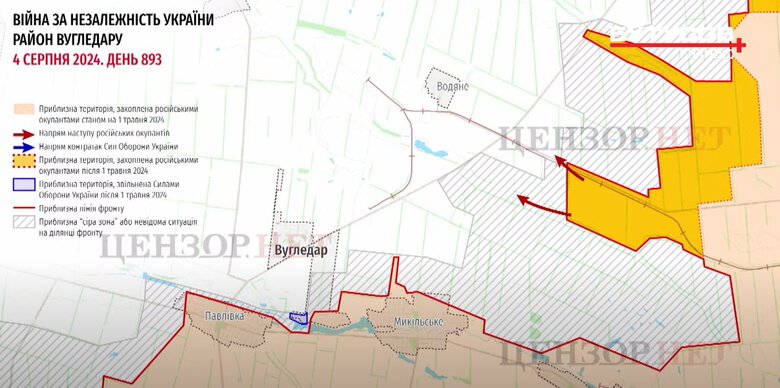
The area of Vuhledar. Here, over the past two months, especially over the past month, the enemy has unfortunately made very, very significant progress. To the north of the city, the enemy managed to break through our defenses and get out, even cut the road from Vuhledar to the village of Kostiantynivka, and get to an important frontage highway that we had in the area. And in fact, there is also a threat of the city being captured from the north. The enemy is advancing, the situation is very dangerous and extremely threatening. There is also a tactical initiative of the enemy here, and they continue their offensive. The situation also requires very much attention.
Staromaiorske area, Urozhaine district. Our 58th motorized infantry brigade, reinforced by some separate units, is holding the line here. There are also very heavy battles in this area. And the enemy managed to capture the village of Urozhaine and the village of Staromaiorske, which were liberated by our troops in 2023 during our offensive in this area. Now the enemy has managed to retake these settlements, but with heavy losses. Both settlements have been demolished, there is just nothing there anymore. And there are heavy losses of Russian troops. In the area of Urozhaine, 70 to 100 units of Russian armored vehicles were destroyed by soldiers of the 58th Brigade, one of the battalions of the presidential brigade, and other our soldiers. Very heavy fighting is going on here.
I would also like to say that heavy fighting is taking place in the area of Robotyne. The fighting continues there on that other ledge that was made. Our soldiers continue to fight the Russians there. At the moment, we have 14 such hot areas of the frontline where very heavy fighting is taking place, where the enemy is trying to constantly advance, throwing reserves into the battle, sending in replenishment. And, unfortunately, we are unable to stop the enemy in most of the areas we have inspected. In many areas, yes, we have controllability and even where there is no withdrawal from the battle, the defense is stable. 58th Brigade in the area of Urozhaine, Staromaiorske, the defense is holding, there is order there. The 79th Air Assault Brigade is working wonders, and there is also battle management and results of combat work. We also have areas where there is order and where the enemy is advancing, but they are being destroyed in much greater numbers. There is order in management, there is an understanding of what the commanders are doing. At the moment, the most critical thing on the front is the uncontrollable situation in the area, uncontrollable at the level of a higher brigade, at the highest level, this is a responsibility, of course, at a higher level, at the level of Myrnohrad, Pokrovsk. This is the most dangerous area right now, because there is the biggest chaos there. Our troops, people, and ammunition are being transferred to this area, but nevertheless, without organizing interaction, without working for results, this offensive cannot be stopped.
I am talking to all, well, to a lot of commanders who are fighting, soldiers, commanders who are fighting now, doing everything possible to stop the Russian offensive. And I want to say that I can now simply analyze and summarise what all our commanders are talking about in all parts of the frontline.
First. In order to stop and defeat the Russian offensive, we need to actually move to strategic defence. We have not moved to strategic defence. Our entire front line is all field positions, dug with a shovel. Our soldiers are engaged in encounter battles all along our frontline with the enemy, who is superior in strength, in the number of people, in the number of weapons. Instead of building defensive lines while these battles are going on, what is the option, what do people say?
First. The lack of defensive lines that have been prepared, where infantry can be brought in, where troop survivability is ensured.
Secondly. The absence of a second line of defense. This defense position is a stable one, which means that while the enemy is assaulting, in the rear of our troops, in the near rear, the second or third line, that is, 5-10 kilometers, 15 kilometers, should be equipped with a position where we are preparing to retreat to this position. So how do we do it? They give operations instructions so that the brigade commander who is fighting in this area can dig something in the rear for himself. Something can be dug, of course, but there are always not enough people. A reliable defense line can only be equipped when troops are sent to this rear line of defense. The troops must be there, fully arrive, fully start preparing for the defense of this line, equip the forefields first, that is, cut down the plantings, cut them off, burn them, which provide approaches for enemy assault groups, mine the approaches, find the range, organize a fire system, take cover from drones, dig a significant number of communication routes, shelters. When this is done, then we can say that the rear position is equipped. And the troops from the first line can retreat there. And the defense will be stable. Unfortunately, this is not the case with us. We have no strategic defense. We are constantly conducting an encounter battle. We are not deployed in defense. The troops are not being stationed on the second line, so they cannot prepare the defense in time. The troops on the first line are hit, they are forced back somewhere and equip something on their own again.
The third is the use of reserves. Our reserves are not used to strengthen the front in time. Here is the brigade stationing, fighting. It is combat-ready. It needs to be reinforced, put in the second line of troops, so that the second line, the reserve, can support those on the first line, improve their tactical position and at the same time have time to dig in. Then those on the first line, when they are knocked out, they move to an organized position and everything is fine there. Unfortunately, our reserves are not used in this way. This is especially evident in Myrnohrad-Pokrovsk. We have a brigade, it is being hit, it is being used as long as it has at least some people on its personnel list. And only when it is completely defeated, the reserve is thrown into the counterattack. What does this lead to? First of all, without reserves, without support, our troops are very quickly destroyed in counterattacks with the enemy. During these continuous assaults. If they were supported in the areas of the enemy's main efforts, where the enemy is advancing, if they were supported, of course, they would hold out much longer. There would be no such fatigue, no such exhaustion. Unfortunately, this is not done. And that's why we have this. The enemy stops where he is completely out of strike force. But, unfortunately, he is passing through, we cannot stop him at the line. They keep moving, moving and moving. In this case, in the area of Myrnohrad-Pokrovsk, if we continue to act in this way, we could lose this key agglomeration. This is absolutely unacceptable.
Fourth. Actions of the enemy. Unfortunately, they are not taken into account. What are the Russians doing? Why are they advancing like this? I want to tell you that most of the replenishment of the Russian army now is people with a low level of combat capability. They are intimidated, of course, by being shot on the spot. The punitive machine is working very well there. But the main thing is that they are advancing because the enemy is making dense combat formations. Where we have a brigade, they concentrate three. And in these striking areas, the Russians are running out of people, we see that they have losses, but the enemy has an overall advantage in this area - three to four times. And they are running out of men, we are killing assault groups, but their replenishment at the tactical level comes faster. And they maintain the pace of the offensive in this area. In other words, they concentrate people on the high ground of the breakthrough. Unfortunately, we do not have such concentration. This is the problem. We are at war, the enemy is at war, advancing in several echelons, and we are defending in one echelon. And we are always more vulnerable. These are obvious things, really. Everyone at the front is talking about it.
Next, what is important to note. The enemy has an advantage in the number of people. How can we compensate for this advantage? What is there in the world that we can have more shells and soldiers than the Russians? Only one thing. Drones. To outnumber the Russians in the number of drones. China and other countries produce far more drones than Russia has people. This means that this is a resource that we can use to kill the enemy. What does the organization of drone operations require? First, the use of drones must be logical. A large number of units should work according to the same plan. In the context of countering the Russian EW technical approaches to organizing the work of drone units must also be improved. There should be both centralized control and rapid supply of drones, frequency changes, performance monitoring, and management. Our army does not fight with drones. In fact, there is a lot of talk about drones in Ukraine, but at the front, the top leadership has no understanding of their use at all. We do not have centralized control over drones. The drones remain in whatever unit is organised, and that's how it works. In most units, there are no tactics for using drones or organizing the management of drone forces in the areas of the enemy offensive. Drones are used exclusively when there is a brigade commander who understands how to do it, and he does it. To the extent that he has enough money. Supply is our main focus, what are we losing in terms of drones? Security. Many times it was said to us that you took away the personal income tax from local governments to provide the army with drones. Friends, there are no such drones. Where? Mavic drones are bought by volunteers, and this is the main reconnaissance drone of our defense forces. It is impossible without it. Neither tactical reconnaissance nor drops bombardment. And the enemy has an advantage in this component. They bomb our units with a much larger number of drones than we can use. In other words, we have a qualitative advantage in terms of the quality of use, but unfortunately, we do not have a quantitative advantage over the enemy. However, where are these supplies? Where are the public funds? Why doesn't the state finance the purchase of drones when it has made commitments? Previously, local budgets financed the purchase of Mavics, Autels, and FPVs for the troops. Now this money has been taken away, and there is no supply from the central budget. How can this be? It's just some kind of real sabotage. Why isn't this controlled by the Headquarters of the Supreme Commander-in-Chief? It's the president's responsibility to make purchases. It was he who said he was raising money to provide the army with drones. It was Zelenskyy who said that there would be a million drones. This is a lie, there are none. Where? It's a complete lie. Along with drones, we must also say that there is no centralized, effective management and use of electronic warfare. A significant number of our drones have been shot down and continue to be shot down by our own electronic warfare equipment. Because there was and is no centralized management of electronic warfare assets, no interaction between electronic warfare units and drones. And this is a very important, very painful problem. It is not being solved. It is not being solved and nothing is being done. It is easy to dismiss our brigade commanders. But it's not easy to build a drone operation. There is no drone frontline. Everything is left to self-organization. Fight there yourself somehow. The units all have to ask for themselves. They can no longer say, 'Give us drones there. Give us drones, mayor, give us drones. Mayor's offices can no longer provide the entire army at the expense of local budgets. They cannot provide the necessary number of drones. Volunteers cannot bring them in for free. There are no funds to centrally provide the army with tens of thousands of drones. And that's it. And, unfortunately, we cannot bomb the Russians as much as we need to at the front. We have operators, but all the commanders are now cheaping with Mavics, saving Autels, not using them for bombing, very rarely limiting bombing to the maximum to reduce the loss of reconnaissance drones. This is a big problem. It is the same with electronic warfare. We are losing drones because our electronic warfare is working on us. And then, when the enemy is working and we cannot cover them, we also lack analysis and management of this area. Unfortunately, this is the situation along the entire frontline. In other words, there is no strategic defence, no use of reserves, no drone control, no second line.
And the fifth important thing is that, unfortunately, we have a lack of combat training. We still send people to the frontline, and now the mandatory minimum training is one month. One month is not enough to train an infantryman. There is nothing like that here. I want to tell you that if we want the survivability of the infantry, their combat capability to be high, if we don't have so many non-combat losses, if we want people to feel more confident when they get into a combat situation, then we cannot, obviously, now, in the 10th year of the war, rely on training in a training center, as they have always said. One month in a training center, where there are a lot of unmotivated instructors who, for example, do not even know how combat operations take place, unfortunately, does not give us full-fledged infantrymen. What was it like before? But you can look, for example, at World War II.
American infantrymen, there was a training course in the American infantry in the year 1944 to reduce the losses of their infantry, the Americans had 44 weeks. It took almost a year to train an infantryman in the Second World War. Why did they do this? Because they wanted to reduce their own losses and increase the losses of the enemy. An infantryman underwent intensive training for 44 weeks and then went to the front. And he already knew everything. He had practiced all his skills in many exercises. Okay, maybe we don't have the opportunity to train infantrymen for 11 months. But not just one month. One month is nothing. The main training problem that commanders talk about is training people, and each infantry brigade has to prepare for itself. Therefore, the best thing to do is not to waste time in training centers, but to create training units and training and combat units in combat brigades that hold significant sections of the front, significant areas. The training cycle should be longer. I want to tell you, if we look at the war in Afghanistan, the Soviet Union is not the United States, there were not 11 months there either, even the war in Afghanistan, the Soviet Union initially sent soldiers there after two months of training, and after they had increased losses in Afghanistan, then in 1984 the Soviet Command increased the course of individual training to five months. Five months, and then they were sent to war, where, in principle, the Soviet Union had an absolute advantage in everything. Now, unfortunately, one month, and one month in a training centre, does not ensure the normal combat capability of an infantryman. In fact, every brigade should be required to train a man after a month, and then train him at the front. They don't have TOE (table of organization and equipment) training units for this, they don't have additional ammunition, and of course, when people are given some reserve at the last minute, they are not given training, they are given, the command believes that they are given ready-made soldiers. And they set tasks based on the number of soldiers they have been given. Therefore, we need to change this situation. Training units and brigades have to train infantrymen for themselves and train them in our conditions. I am not talking about 11 months, as in the American army, in World War II. It should be at least 2 full months.
Now the Third Assault Brigade, for example, the Charter Brigade, is conducting additional training after the training centres, which is a two-month training cycle. Obviously, if the brigades had the 3 months provided for in the plan, the quality of training would be higher. In other words, three months is a high level of training for an infantryman. This means that a person will be physically fully prepared, he will have a perfect knowledge of tactical medicine, weapons, engineering, camouflage and survival in field conditions. It will be complete. That means that for big challenges, the training period needs to be extended to two or even three months. This is justified - up to three months. Up to three months in the training units of the combat brigades themselves. This will result in a much higher quality of human resources. And many more people will survive. This is the main thing for us.
The sixth area that is important to mention. This is resource management. Of course, we must centralize the supply of ammunition to the troops. The supply of ammunition must be distributed objectively. We need to increase our own production. It is strange to say this, but I cannot help but mention it as one of the important factors. And we need, of course, the use of drones. We need to supply drones of all types, we need to use transport and small means of evacuation. That is, ATVs, buggies. Without this, it is impossible to survive in today's conditions. We need a centralized supply of troops and electronic warfare systems. When I say centralized, I don't mean that it should be like it is now. When we have FPV drones, the state has issued tasks to several of its manufacturers that we know. They signed large contracts for FPV. They cannot fulfill them. These drones become obsolete in the process of development and supply. They cannot ensure quality in large batches. We don't need to focus on quantitative indicators. There must be quality. Drones and electronic warfare equipment should be purchased every month, a new batch with new characteristics. But it should be a constant flow. Currently, electronic warfare equipment is purchased exclusively at the expense of soldiers and volunteers. How can combat operations on a front a thousand kilometers away be self-financed? The main drones, Mavic, Autels, FPVs, most of them, the vast majority, are volunteers, again, using their own money. How can you fight like that? If there is a lack of resources, long-range missiles, something else, let us provide some segment where there is a centralized adequate supply. And then we won't be able to supply the whole army. This is not to say that a miracle will happen, and we will give everyone everything. No. Resource management. Centralized batch purchases are needed to concentrate the necessary funds in certain directions. For example, there is Myrnohrad-Pokrovsk. There should be a centralized organization for managing drones and electronic warfare, and the state, not just volunteers, should organize centrally-controlled supply of at least some of these means, noticeable, which can make a difference at the front. And now the state does not have such a resource. And, frankly, in the absence of a centralized supply of drones, electronic warfare equipment, transport, it is impossible to ensure the combat capability of the troops right now. Because the enemy is attacking intensively, with a large number of high-precision weapons, drones, missiles, bombs. The equipment is out of order. There are significant losses. But it is better to lose equipment than people. Well, I think I'm saying obvious things that, unfortunately, are not being done. Therefore, if we do all these factors, a miracle will happen. If we have certain reserves at least one section of the front line, one or two lines. If they don't build castles in the air in higher-ups and send a high-quality large unit to the Pokrovsk-Myrnohrad direction, and this large unit is stationed in some normal area, at least in one area, it will be on the defensive, will have time to dig in for at least a week, will have time to burn out, cut down the plantings in front of them by at least a kilometer and a half so that the enemy does not approach undetected, if this large unit has time to dig in, cover itself from enemy drones, provide logistics, hiding places, shelters, we will be able to stop the enemy. We have such large units. In the area of Myrnohrad-Pokrovsk, we do not have enough combat-ready formations that can be deployed to become the core of defense, around which we can join weaker, broken, exhausted military units. And to strengthen the defense. Without this, no miracle will happen. We should not count on miracles in war. War is a technological process. It is a confrontation between two systems. Our system should be more flexible, more efficient. I do not know what is needed for this. We have lost Krasnohorivka this year, we have lost Avdiivka this year. What else do we need to lose? The enemy has already entered Chasiv Yar, Toretsk, New York, and is approaching Myrnohrad and Pokrovsk. What else is left to lose? What else needs to be done to make the government realize that they are expected to make decisions?
War requires centralized decisions. This is the only thing they can do. The Headquarters of the Supreme Commander-in-Chief must provide resources and clear tasks. The Armed Forces Command has to build some kind of vertical command structure, which it does not have. There are no divisions, no corps, no armies, no administrative instruments. We have Syrskyi in command of brigades. This is the reality. Sometimes it's good when a strong brigade understands the situation and its combat capability. And when there is no combat capability, the situation is chaotic, how can you manually control the entire front? It's absurd. No one can do it. It has never been possible in world history. We have to make systemic changes from the top. And before you shift your responsibility to the brigade commanders, Mr. Zelenskyy, Mr. Syrskyi, please look at yourselves. What are you doing to ensure that you provide adequate management and organization of troop supply? What are you doing? Because you have more problems now than the troops in the trenches on the front line. There is more chaos and disorder in your work than there is at the defensive post. And until there is more order at the top, there will be no order down there, on the ground, in the positions. And these maps that we have shown are, unfortunately, tens of square kilometres that the enemy has managed to capture over the past two months. Tens of square kilometres. But, I want to tell you, this is the enemy's land of great advantage. I want to tell you that it is very painful that every square kilometre, what you saw in all areas, is covered with the blood of hundreds and thousands of Ukrainian patriots. This is painful. And this is an obligation for us - to correct the situation, to improve it, to force changes on those who make decisions. And, unfortunately, I understand that we have no other factors to reach the minds of the Headquarters of the Supreme Commander-in-Chief except public opinion and criticism in the media. I don't know what else is needed when this rat race just keeps going on and on, there are no changes. People at the front ask me what is going on? Are we really surrendering the Ukrainian Donbas? I convince everyone that, in my opinion, this is just irresponsibility and chaos in the minds. I hope that something else will happen, and instead of evening videos, people will start to deal with the essence of the problem, start asking questions, look critically at themselves, at their irresponsibility and helplessness. There is nothing complicated about it. I've just told you the things that are most talked about at the front. They talk about it. These are simple things, elementary in execution. You don't have to be Napoleon, you don't have to be... You have to do basic things, and it won't be a miracle, it will be just us stopping the enemy. The Russian offensive will be defeated. The enemy is not doing anything special.
I want to say about the actions of the Russian troops. They are absolutely standardized. Frontal attacks by small groups of infantry. Sometimes they use large armoured columns or small groups of vehicles. But the main thing is small groups of infantry. They are very vulnerable, the enemy suffers huge losses. Is it possible to stop them? Of course, it is. Is it possible to defeat the Russian offensive? Yes. Do we have the forces to do so? Yes. Our main problem is the organization of troop management. The organization of resource management for war, which should be provided by the government, should be provided the army. These are the main problems at the highest level. Not at the level of people. Therefore, it is absurd to blame the soldiers for running away somewhere, or some brigade commander for failing to withstand in the direction of the main attack - it is absurd. First, we need to build a strategy. We have to move from words about defense to real strategic defense. And now we don't have it. And until we have a strategic defense, we cannot stop the Russian offensive. And this is a great threat. And this is a great bloodshed. Friends, I understand that we will have to talk about this more, talk about it constantly, because the threatening situation in the Myrnohrad-Pokrovsk area requires maximum attention of the whole country, the whole state. And our realities are such that the authorities only respond to what is constantly discussed here. Therefore, without our dissemination, without our constant attention in social networks, unfortunately, there will be no reaction. We will continue to talk about this topic.
Dear friends, we have someone to defeat the Russian troops, we have someone to destroy and defeat the Russian offensive. I believe in the people who are defending our country, they are doing everything possible at the front and even much more than is possible. Thank you for the broadcast, thank you for being with us, thank you for your support. Today, more than ever, I am confident in our victory and that we can defeat the enemy. Thank you and Glory to Ukraine!


